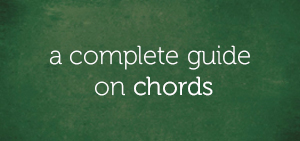In most chords, only two fingers really matter. And the truth is: You can get rid of all the other tones in your chord, keeping only these two notes and your chord will still sound great.
What are those tones?
Answer: The 3rd and 7th degrees of your chord.
Let me explain.
Major 7th chords are formed by taking the 1st, 3rd, 5th, and 7th tones of your major scale and playing them together:
For example, in C major, the scale is:
C D E F G A B C
All you do is number that scale from 1 to 7:
C is 1
D is 2
E is 3
F is 4
G is 5
A is 6
B is 7
This now gives you everything you need to know to form all types of chords.
C major 7 = 1 + 3 + 5 + 7
That would be: C + E + G + B
C minor 7 is 1 + b3 + 5 + b7
When you see a “b” in front of a scale degree, it simply means to lower that note by a half step. So if “E” is the third tone of the scale, Eb is the b3 (aka – “flatted third”) tone of the scale.
That makes C minor: C + Eb + G + Bb
C dominant 7 is 1 + 3 + 5 + b7
That’s: C + E + G + Bb
C diminished 7 is 1 + b3 + b5 + bb7
That’s: C + Eb + Gb + Bbb (aka – “A”)
Note: Diminished chords lower the already-lowered “flatted 7th,” which gives us a double flat. You can either call it “B double flat” or just keep it simple and call it “A” (although technically wrong as you wouldn’t want anyone misspelling your name!)
Now, since the only notes that matter are the 3rd and 7th, try these ways to play each of the chords above:
C major 7
C on left /// E + B on right
C on left /// B + E on right
C minor 7
C on left /// Eb + Bb on right
C on left /// Bb + Eb on right
C dominant 7
C on left /// E + Bb on right
C on left /// Bb + E on right
C diminished 7
C on left /// Eb + A on right
C on left /// A + Eb on right
Using 2-fingered chords in chord progressions
Try this famous “2-5-1-4” chord progression using only 2 fingers:
D minor 7 (2nd tone of the scale – “2”)
G dominant 7 (5th tone of the scale – “5”)
C major 7 (1st tone of the scale – “1”)
F major (4th tone of the scale – “4”)
Until next time!







Comments on this entry are closed.